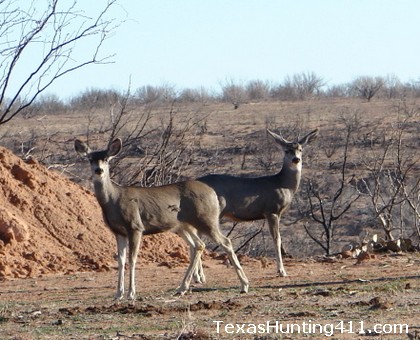White-tailed deer are not the only game in Texas. The mule deer hunting found in the Trans Pecos as the Texas Panhandle can be good. The brush and grass dominated country found in West Texas may be dry, but it can grow some big ole mule deer, especially near agricultural areas. Hunters should be excited because it looks like the mule deer hunting season is Texas is getting a little longer.
At least for landowners that are trying to manage their property. Texas Parks and Wildlife Department (TPWD) will be extending the existing mule deer Managed Lands Deer Permits (MLDP) season. The regulation change will be part of changes to the upcoming 2013-14 Statewide Hunting Proclamation. The longer hunting season for mule deer will mean more opportunity for deer management on lands looking to improve habitat and manage deer herds.
TPWD is extending the mule deer season on MLDP properties through the last Sunday in January, while maintaining the current opening date as the first Saturday in November. Over two months of mule deer hunting in Texas.. now that s something to get excited about!

Mule Deer Hunting – Know What They Eat!
Whether a mule deer herd is being managed for quality antler production or high deer numbers, nutrition is the most
important factor to consider. Mule deer require a diet of approximately 16 percent protein along with carbohydrates, fats, vitamins and a variety of trace minerals. No single forage provides adequate levels of all these requirements, which emphasizes the importance of managing for a wide variety of shrubs/succulents, forbs and grass. The Trans-Pecos Region has a tremendous diversity of vegetation types which can provide excellent nutrition for mule deer, especially when rainfall is adequate. Vegetation in the Panhandle is less diverse, but some mule deer herds are on a high nutritional plane because of a combined diet of native forages and crops such as wheat, alfalfa, corn and/or sorghum.Deer are selective feeders, eating a wide variety of the most nutritious foods available during each season of the year. Deer food plants can be classified as shrubs, succulents, forbs and grasses. The leaves, twigs and blooms of woody plants eaten by deer are called browse. Succulents such as cactus, lechuguilla and cholla may be included in this category. Water obtained from succulents is important in the arid Southwest and perhaps critical if free water is not available. The bulk of Texas mule deer diets consists of browse, representing approximately 70 percent. Many browse species are deciduous, losing most of their leaves after the first frost; therefore, evergreen browse is an important food source during the fall and winter period. Juniper (an evergreen) is not highly palatable or nutritious, but it can be an important source of energy and Vitamin A during winter when higher quality foods are absent.
Forbs are annual or perennial broadleaf plants and are highly preferred by deer when available. Although their availability is highly variable, forbs average about 25 percent of a deer’s diet. Forbs are usually the most nutritious and palatable class of plants, often exceeding 14 percent crude protein. Annual forbs are seasonal plants, and their abundance depends on soil moisture. As a result, they may be virtually non-existent during times of prolonged drought. For deer management purposes, annual forbs are not considered a reliable source of mule deer nutrition. Perennial forbs provide a more reliable source of forage, and they generally will be present on properly managed ranges. However, some of the higher quality perennial forbs may be scarce or lacking on many ranges, as livestock overgrazing and excessive deer numbers can limit their availability.